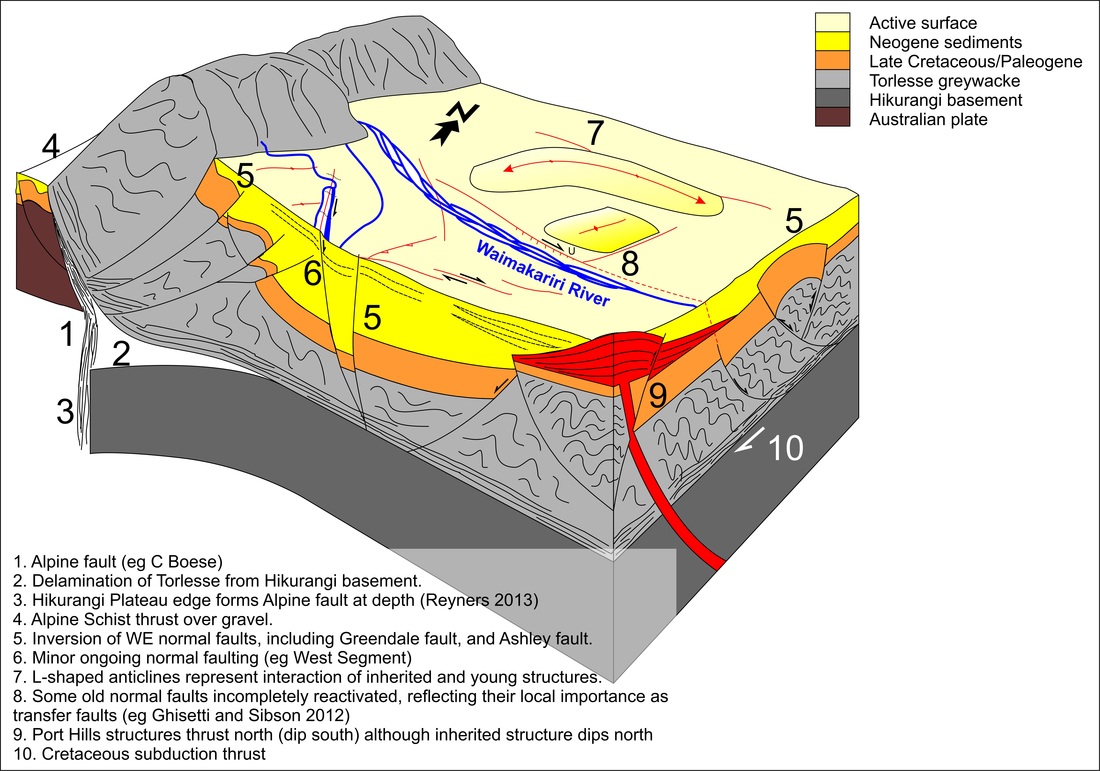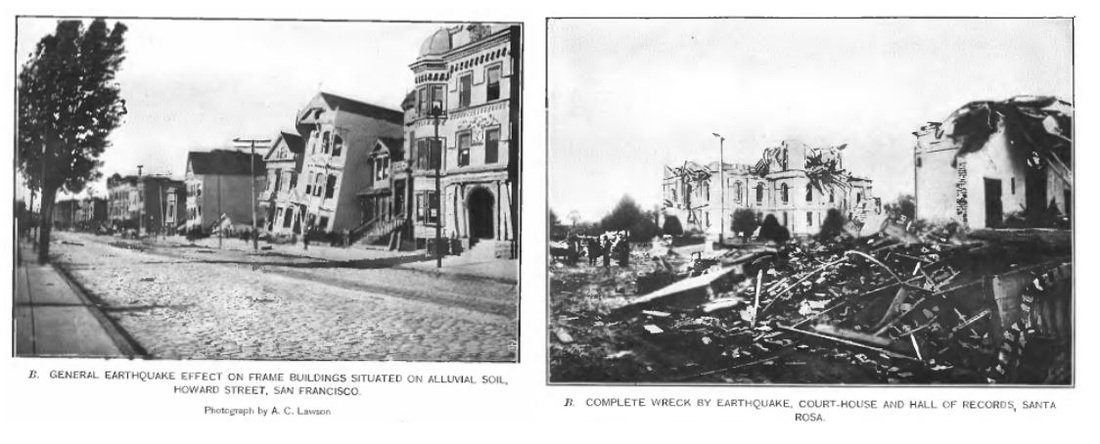Canterbury Tectonics - why bother?
The sustainability of future social and economic development in Canterbury hinges on a robust understanding of our seismic hazard. During large earthquakes, the ground may break and/or warp for tens to hundreds of meters around where the fault reaches the surface. This is known as ground rupture. It poses a significant hazard close to the fault but is restricted in extent. Most people do not live within a couple of hundred metres of a fault. Further away, where most people live, the main hazards are caused by shaking as a result of radiated seismic waves. For people living within a few km to many tens of km of a fault, it is the shaking that is of greatest concern. Key points to consider when you think about shaking are the frequency content (is it dominated by severe vibration - caused by high frequencies - or is it more of a roll - caused by low frequencies?) and the duration of the shaking (how long does it last). For a given site, lower frequencies are more damaging to taller buildings and higher frequencies are more damaging to shorter buildings. Also, for a given frequency, the number of cycles of shaking depends on how long the earthquake continues. So, lets consider why we need to understand faults when most people are not on the faults and are mainly affected by shaking?
The frequency content and duration of shaking, which control the extent of the damage, are controlled by three groups of factors.
1 - the size and type of the fault, known as SOURCE EFFECTS -
2 - the distance and type of rock that lies between the earthquake and the place where it is being felt, known as the PATH EFFECTS
3 - the type of rock or soil, and its water content, in the 30 or so meters below a site.
The frequency content and duration of shaking, which control the extent of the damage, are controlled by three groups of factors.
1 - the size and type of the fault, known as SOURCE EFFECTS -
- Size - A long fault produces more low frequency shaking than a short fault. Also, the earthquake starts at a point and spreads along the fault, so at a given speed of rupture (think unzipping), a longer fault produces a longer earthquake. The amount of seismic energy radiated in a given earthquake is also greater for longer faults.
- Type - In general, thrust faults, which push one rock over another and make the crust thicker, radiate more seismic energy than strike-slip faults (rocks move horizontally past each other) or normal faults, which pull the rock apart.
- So, it is necessary for geologists to evaluate the length and type of faults in a given region in order to understand seismic hazard.
2 - the distance and type of rock that lies between the earthquake and the place where it is being felt, known as the PATH EFFECTS
- Earthquake waves passing through the crust begin to lose their high frequency content because the high frequency waves find it difficult to pass across fractures in the crust. That is why distant earthquakes feel like a gentle roll, while close earthquakes can produce violent shaking. The gentle roll is the very lowest frequencies, which are all that remain by the time the seismic waves have travelled a long way.
- Earthquake waves passing through young sediments (such as beneath Christchurch) lose their high frequency content even more quickly, because of the large number of interactions between sediment grains.
- So, it is important to know how far away a given site is from an earthquake source, and what the intervening rock types are, if we are to predict the range of frequencies likely to arrive at that site.
3 - the type of rock or soil, and its water content, in the 30 or so meters below a site.
- 30 m sounds like a lot (its the length of most suburban sections) but it is very little compared with the distance travelled by earthquake waves that are arriving at a site. Even if the earthquake was directly under your house, the waves have probably travelled 5-10 km before they arrive. However, it has been known for over a hundred years that the type of soil and water saturation are key predictors of earthquake outcomes. After the great earthquake in San Francisco in 1906, Soule wrote
- “The destruction wrought by earthquake in its severe effects was proportional in a way to the nearness of the locality of the fault trace, but varied greatly according to the character of the rock and soil formation throughout the disturbed area. [It] amounted to little or nothing in well built structures resting upon solid rock and, all other things being equal, increased in proportion to the depth and incoherent quality of the foundation soil. [Santa Rosa], built upon a deep alluvial soil, was more severely shaken and suffered greater damage, in proportion to its size, than any other town in the state”
Getting back to the importance of faults in this picture, the people of Canterbury now know very well that earthquakes are rarely limited to a single fault. Instead, they typically rupture an interconnected mesh of faults, each of which has its own length, and each of which contributes to the duration of shaking and the frequencies arriving at a site. A good example from outside New Zealand is the Landers earthquake, in southern California in 1992. One earthquake may also hasten earthquakes on adjacent faults, as may have occurred with the Hector Mine earthquake that followed Landers by some 7 years. So, if we want to understand the potential for shaking of our patch of Godzone, we need to know not only how far we are from any particular fault, but which other faults it likes to party with.
There arises my interest in Canterbury tectonics - I wish to understand the linkages between faults, by understanding how the landscape develops as a result of the interactions of faults. Then, I can use that knowledge and a bit of digging to understand how prehistoric earthquakes cluster on faults and whether that clustering reflects single large or multiple small events.
There arises my interest in Canterbury tectonics - I wish to understand the linkages between faults, by understanding how the landscape develops as a result of the interactions of faults. Then, I can use that knowledge and a bit of digging to understand how prehistoric earthquakes cluster on faults and whether that clustering reflects single large or multiple small events.


